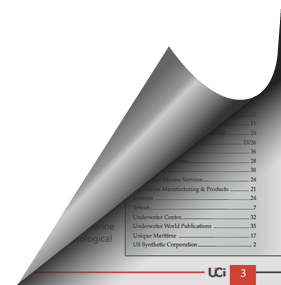
The Magazine for Underwater Professionals
![]() Mar/Apr 2019
Mar/Apr 2019
PRODUCT EYEBALL
'Incredible' quality
JWF dedicated to advancement of underwater video systems
Approximately 71% of our planet is covered in water. An in-depth 2012 study estimated that up to one million species live in our oceans, with up to 66% not yet named or even discovered. There are literally hundreds of thousands of marine species waiting to be captured on video and shared with the world.
There should be no question that the tools to capture underwater video will continue to enjoy strong demand; especially as technological advancements dramatically increase the capabilities and effectiveness of these tools.
The earliest underwater film is generally accepted to have been recorded in 1940 by Austrian biologist and diver Hans Hass; it premiered in Berlin in 1942. Titled ‘Pirsch unter Wasser’ (Stalking under Water), the film was 16 minutes long and was shown in theatres as a preview to main events. Later on, the film was extended when additional footage was taken and, in 1947, Hass released an 84-minute underwater film titled ‘Menschen unter Haien’ (Men among Sharks).
In 2019, USA-based JW Fishers (JWF) continues to develop advanced underwater video systems which it offers throughout the world for a variety of projects by many different entities. “The MC-2 mini-camera, which was recently upgraded from the MC-1 to include powerful LED lights, is the ideal tool for commercial companies in need of capturing underwater video footage while utilising a diver,” says the company. “Many customers mount the camera on their helmet and keep in contact with ship-based surveyors via JWF’s VRM video recording system.”
The system also allows the mini-camera to be pole mounted for easy manipulation and deployment in hard to reach places, notes JWF.
LEAK
One company that successfully utilises JWF’s MC-1 mini-camera and VRM system to conduct inspections for its clientele is W.J. Castle PE & Associates of New Jersey, USA. The firm was recently hired by a local municipal water authority to complete an underwater investigation of a portion of a water distribution system. The client suspected a potential leak in a portion of the system. However, due to the configuration of the distribution network, access was all but impossible without a competent dive team.
“Using a combination of the MC-1 camera and the VRM-1, the Castle team was able to achieve mission success and provide clear video footage of the underwater conditions. The client’s representatives were happy to be onsite for the dive and to watch the video footage in real-time, which allowed for dynamic mission updates when necessary,” says JWF.
Another Castle mission that required the MC-1 Video System was for Hydro Marine Construction, USA. It hired Castle to complete an underwater video inspection of a portion of a dam in Pennsylvania. The inspection targets were the upstream portion of a large intake structure in approximately 45 feet (14 metres) of water. Diver Zach Amodio was able to complete the inspection safely and in accordance with dive safety standards. “The video quality was incredible,” he says.
JWF says: “There will always be a strong demand for capable, effective and efficient underwater camera systems for as long as there is a need to discover, re-discover, or evaluate underwater objects. In many cases, remotely operated solutions are not capable, manoeuvrable or small enough to achieve mission accomplishment in a timely or affordable manner. We are committed to remaining on the cutting edge of underwater camera design and are proud to offer the right tools for the job in any dive, survey or search operation.”


